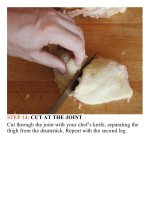The food lab better home cooking through science ( PDFDrive ) 791
Bạn đang xem bản rút gọn của tài liệu. Xem và tải ngay bản đầy đủ của tài liệu tại đây (133.9 KB, 2 trang )
to cook lamb for yourself at home yet, you’ve really have
noexcuse.
Whatbettertimetostartthannow?
DOMESTICVERSUSIMPORTED
Q:IseelambfromAustralia,NewZealand,andthe
UnitedStatesatthebutcher.Whatarethedifferences
betweentheseoptions,andisonebetterthananother?
There are major differences in terms of flavor, size, and
price when it comes to American lamb versus lamb from
DownUnder.NewZealand/Australianlambsarequitesmall
insize,withwholelegscominginataround5to6pounds.
According to Mark Pastore, president of Pat LaFrieda, one
of the most respected meat purveyors in the country, their
size is a matter of both genetics and feed. The lambs are
smallertobeginwith,andtheyspendtheirlivesgrazingon
grass. Grass gives them a more gamy flavor, which some
peoplefindoff-putting,andtheyalsotendtobelowerinfat,
making them a bit harder to cook properly—the legs in
particular have a tendency to dry out.That said, if you’re
cookingforasmallerparty—6to8peopleorso—andyou
value that gamy flavor over tenderness or richness, NZ or
Aussielambisagoodchoice.
American lambs are larger, fattier, and sweeter in flavor.
Most American lambs are fed on grass for most of their
lives, supplemented with grain for the last 30 days before
slaughter. The lamb at LaFrieda comes from Mennonite
farms in Colorado that finish their lambs on a combination
ofgrain,honey,alfalfa,wheat,andflakedcorn.Theresults
arealargerlayerofprotectivefataroundthelegsandbetter
marbling (the intramuscular fat that adds flavor and
moistness to meat). Because of the grain supplements,
Americanlambtendstohavealessfunkybutricherflavor,
more similar to steak. A single leg of American lamb can
weighupto15poundsorso,withenoughmeattofeedover
adozen.
Q:I’vereadthatgrass-fedmeatisalwaysbetter—better
tasting,betterfortheanimal.Isthereanytruthinthis?
It depends. Some people prefer the gamier taste of 100percent grass-fed lamb, others prefer the richer flavor and
juicier meat of grain-finished lamb.As far as the health of
the animal goes, while it’s true that an animal that lived
solely on grain would eventually develop health problems
(much like a human who existed solely on hamburgers),
grainfinishingonlyoccursoverthelast30daysofalamb’s
life, after which it’s going to be slaughtered anyway.That
time period is not nearly long enough for the animal to
developanyhealthproblemsthatwouldcauseittosufferin
any way. If you have no problem eating meat, you should
havenoproblemeatinggrain-finishedlamborbeef.
Q:Whataboutthepricedifferences?
Unfortunately,American lamb tends to be more expensive
thantheimports,despitetheirlongjourneyacrosstheglobe.
It’s a matter of scale. Australia and New Zealand’s lamb
outputisseveraltimesgreaterthanthatoftheUnitedStates.
If you value tenderness and juiciness, the extra cost is
probablyworthit.









